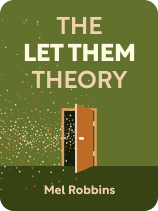

This article is an excerpt from the Shortform book guide to "The Let Them Theory" by Mel Robbins. Shortform has the world's best summaries and analyses of books you should be reading.
Like this article? Sign up for a free trial here.
How do you react to a person’s comment that just isn’t worth the battle? What if there were a way you could win the battle without even fighting it?
To escape the trap of trying to control what other people do and say, Mel Robbins contends you have to acknowledge that you can’t manage everyone else’s opinions, judgments, and feelings and redirect your energy and focus to what you can control. She explains that to do that, you can use two simple phrases: “Let Them” and “Let Me.”
Discover how to use these phrases in everyday situations.
“Let Them” and “Let Me”
The key to using the phrases “Let Them” and “Let Me” is that you don’t use them separately. You use them together. When you say “Let Them,” you consciously detach from other people’s behaviors, opinions, and emotional reactions. This frees you from wasting time and energy on things you can’t control or wishing you could change the people around you—people who might not actually want to change.
Robbins says that saying “Let Them” saves you time and energy and might make you feel relieved, but she cautions that it might also make you feel superior because you can blame the other person for their “bad” behavior or “wrong” opinions and move on. It can also lead you to withdraw from the situation and from your connection with others. This is where “Let Me” comes in.
“Let Me” means you take responsibility for your own actions, thoughts, and feelings in response to the situation. Robbins explains that when you say “Let Me,” you empower yourself to focus on your values, your attitude, and your actions as you move forward. By combining “Let Them” with “Let Me,” you regain control of the situation—and give grace to others.
For example, when a family member offers unsolicited advice about your life choices, you can “Let Them” have their opinion without internalizing it. After all, their perspective isn’t a reflection of your values or the validity of your decisions. Then, you can remind yourself to “Let Me” decide how to move forward, given the values and goals you’ve defined for yourself.
(Shortform note: Robbins’s approach parallels Acceptance and Commitment Therapy (ACT), a framework to help people embrace difficult thoughts and feelings while acting in ways aligned with their core values. The idea is that accepting your emotions, rather than fighting them, helps you move beyond them more effectively—much as Robbins advocates accepting that others will think, feel, and act in ways you can’t control. Russ Harris (The Happiness Trap) notes that acceptance isn’t the end goal—it just helps you to take “committed action” based on your deepest values. Both ACT and the Let Them Theory can help you develop psychological flexibility, the ability to be in the present moment while acting in ways that serve your values.)
Robbins explains that practicing “Let Them” and “Let Me” doesn’t require you to give up on improving a situation or to let go of your feelings: Her method just gives you a way to free yourself from your natural tendency to try to control what you can’t control. She contends that the key to making your relationships healthier and your life happier is to use your own goals, priorities, values, and feelings—rather than what others say and think—to determine what you should do and how you should do it.
(Shortform note: In Let Your Life Speak, Parker J. Palmer writes that to discover your vocation and your values, you have to listen to your inner voice and overcome the temptation to conform to external expectations. Writers from Palmer to Henry David Thoreau (Walden) have noted that we often repeat what we’ve heard other people say instead of reflecting on our own authentic priorities. To discover your authentic values, Palmer suggests you must pay attention not only to the parts of yourself that you like, but also the ones that you aren’t so proud of. It’s only by seeing your whole self, including your limitations, that you can see a complete picture of who you are and what’s most important to you.)
Robbins explains that as you integrate the Let Them Theory into your daily life, you’ll reduce your stress levels and increase your sense of empowerment to build the life that you want. Situations that once made you feel frustrated or anxious will become opportunities to exercise your newfound ability to let go of what you can’t control and direct your energy toward more constructive pursuits. While “Let Them” involves accepting others for who they are, “Let Me” requires taking full responsibility for your own life. It’s about recognizing that you are the only one who can create the changes you want.
| Why Do We Think We Can Control Other People? Neuroscience is just beginning to explain our persistent but erroneous belief that we can control other people. Researchers have found that our brains engage in “forward thinking,” or planning multiple steps ahead, when we try to influence others, much like a chess player anticipating their opponent’s moves. In one study, participants played bargaining games while researchers observed their brain activity. Even when the participants had no control over outcomes, they still reported feeling they had significant influence over their partners’ decisions in situations where they actually had none. This illusion of control appears to be driven by a region of the brain called the ventromedial prefrontal cortex (vmPFC), a decision-making center that’s involved in planning. When we interact with others, this brain region automatically calculates potential outcomes of our actions. This creates the sense that we’re in control of the situation, even when we’re not. This neurological predisposition explains why Robbins’s advice to “Let Them” feels so counterintuitive: We’re literally fighting our brain’s default settings. The stress, anxiety, and energy depletion Robbins describes as effects of trying to control others may even be the effect of our brains working overtime to calculate influence strategies that can never succeed. |

———End of Preview———
Like what you just read? Read the rest of the world's best book summary and analysis of Mel Robbins's "The Let Them Theory" at Shortform.
Here's what you'll find in our full The Let Them Theory summary:
- A simple but powerful framework for reclaiming your time and mental energy
- How to detach from situations and behaviors that are outside your influence
- How the "let them" theory can be taken too far, and how to avoid it from happening






